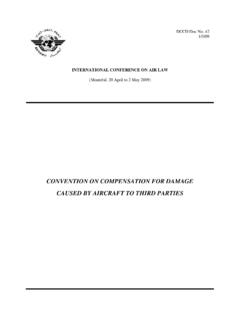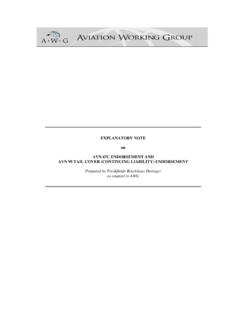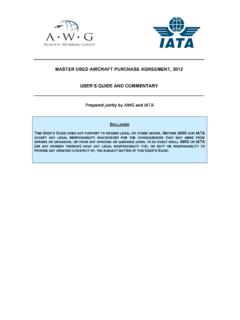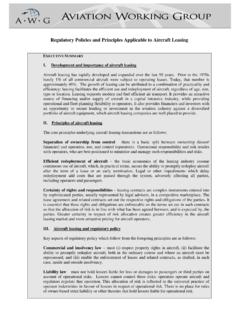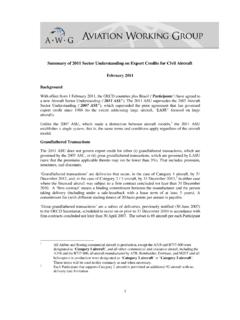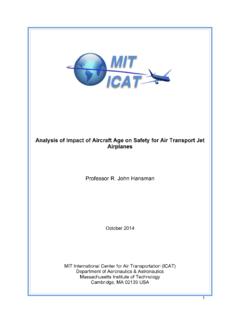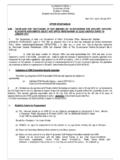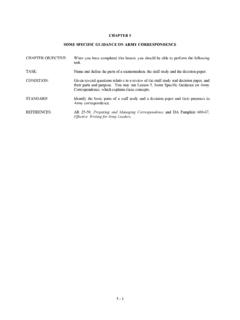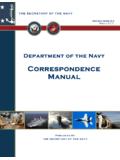Transcription of Memorandum on Aviation Insurance in the …
1 Memorandum on Aviation Insurancein the context ofFinancing and LeasingJuly 2010 ContentsPageIntroduction1 Aviation Finance and Leasing2 Aviation Insurance4 Introduction4 The position prior to AVN674 AVN67 a standard form of endorsement for financiers and lessors5 The transition to AVN67A and AVN67B7 Breach of warranty cover for financiers / lessors under AVN67B8 Conclusion9 The placement of AVN67B risks10 Disclosure in relation to the Structuring of Finance and ContractualDocumentation111 Memorandum on Aviation Insurancein the context of Financing and Memorandum has been prepared by the Aviation Working Group AWG . AWGbegan work in 1994, at the request of the International Institute for the Unification ofPrivate Law (UNIDROIT), as an ad hoc industry group to contribute to thedevelopment of the Cape Town Convention on International Interests in MobileEquipment and the Protocol to the Convention on International Matters Specific toAircraft Equipment, which was signed in 2001.
2 In 2002, the AWG became a not-for-profit legal entity and its scope of activity has significantly expanded. It nowaddresses a wide range of topics affecting international Aviation financing, includingissues relating to Insurance . For example AWG was heavily involved in thediscussions to update AVN67B to AVN67C in 2007. AWG is also a forum forconsidering new issues as they emerge and develop, as well as continuing to monitorissues of importance to the international Aviation financing and leasing is co-chaired by Airbus and Boeing, and its members and affiliates comprisethe major Aviation manufacturers and financial institutions, including most of theworld s largest leasing companies. AWG s members and their affiliates manufacturesubstantially all modern commercial aircraft and engines, and lease and finance asubstantial majority of such new equipment.
3 The following are members of AWG:Airbus; Boeing; AerCap; Aircastle; ATR; Aviation Capital Group; AWAS; BNPP aribas; BOC Aviation ; Bombardier Aerospace; Calyon Airfinance; Citibank;Deutsche Bank; Dubai Aerospace Enterprise Ltd; DVB; Embraer; General Electric;GE Capital Aviation Services; Goldman Sachs; International Lease FinanceCorporation; JPMorgan; KfW IPEX-Bank; Mitsubishi Corporation; Mitsubishi RegionalJet Corporation; Morgan Stanley; RBS Aerospace; Rolls-Royce; SAFRAN and UnitedTechnologies Corporation (Pratt & Whitney Division). this Memorandum the following topics are addressed: A brief overview of the Aviation finance and leasing industry and thedocumentation involved. Aviation Insurance in the context of aircraft financing and leasing and, inparticular, the role of the AVN67B endorsement and its Finance and is one of the fastest growing and most dynamic sectors of the worldeconomy.
4 By way of example, according to the Airbus Global Market Forecast for2009 2028, the demand for new passenger (over 100 seats) and freight aircraftover this period will result in 24,951 new deliveries (worth US$ trillion) and that theworld s fleet will grow from 15,750 aircraft in 2009 to nearly 32,000 aircraft by Boeing Market Outlook for 2010 2029 (which includes regional jets) anticipatesdelivery of 30,900 new aircraft over that period, with a value of US$ trillion, and anincrease in the global fleet from 18,890 aircraft in 2009 to 36,300 aircraft in need to finance the ever increasing demand for aircraft and airline travel hasmeant that dynamic and innovative developments have occurred to meet therequirement for such finance. The situation was far simpler in the early days ofcommercial Aviation where until the late 1970 s there were relatively few airlines -most of which were state owned - which financed their aircraft either from fundsprovided by their government shareholder or commercial bank loans secured on thestrength of the airline s balance sheet or from share issuances.
5 It was also the casethat aircraft were comparatively cheap. In the late 1960 s the typical value of aBoeing 707 or McDonnell Douglas DC8 aircraft was between US$5 US$7 millioneach, whilst the first Boeing 747 s which were delivered in the late 1960 s were soldfor around US$20 million. This should be compared with the substantial agreedvalues today of a new Airbus A320 or Boeing 777-300 aircraft, whilst the cost of anew Airbus A380 is beyond the contemplation of any airline or financier 30 the dramatic changes that have occurred in the industry it is not surprising thatthe methods used for the financing of the continuing supply of new aircraft, as well asproviding for the acquisition of older aircraft, have developed and are now extremelywide and varied. If one ignores the acquisition of aircraft from an airline s ownfinancial resources or from external non-aircraft related sources such as the capitalmarkets, there are broadly two alternatives for basic financing based on the value ofthe asset itself.
6 One is based on the ownership of the aircraft, where, for example,the aircraft is financed by the owner but leased to an operator; the other is based ona security interest in the aircraft, where the operator owns the aircraft but creates amortgage over it by way of security to the person lending the finance. These two3fundamental alternatives are frequently blended and used in combinations to createthe many types of transaction that are actually used. The precise method which isused depends on a wide variety of factors, such as: the size and type of the aircraft; the requirements and financial strength of the airline; tax, accounting or insolvency considerations; any relevant local law requirements; the relevant Aviation authority; and whether or not protection is available to the financier under the Cape TownConvention, referred to in paragraph 1 of this complexity of a transaction and the parties involved depend very much on thestructure chosen in the light of those factors mentioned above.
7 So for example, atransaction can be as easy as a simple loan to an airline secured by a way of amortgage or can be a hugely complex transaction involving syndicates of banks,investors, special purpose companies and export credit agencies dealing with newaircraft deliveries to airlines. A particular feature of the industry is the growth in thelast 30 years of specialist aircraft operating leasing companies which lease an aircraftunder an operating lease to an operator which acquires its use without the obligationto pay off the full cost of ownership, either directly or indirectly. The operator will beresponsible for the operation, use and maintenance and Insurance of the aircraftwhilst it is in its control and for the return of the aircraft with the engines and theirrecords all in a prescribed condition and location and following any tests orinspections agreed in the length and number of the documents has also changed.
8 In the 1960 s, in theage where documents were typed on a manual typewriter and word processing, letalone electronic correspondence, was unheard of, the documentation tended to bevery short. Now there is a vast range of documentation involved, even in relativelysimple transactions, such as a commitment letter, term sheet, confidentialityagreement and facility agreement. There may also be any number of securityagreements, sub-participation agreements, assignment agreements, agencyagreements and trustee this section, we address the topic of Aviation Insurance , with particular emphasison how the Insurance industry has accommodated the requirements of financiers /lessors in the face of the dramatic changes which have taken place in the aviationfinance and leasing sector since the 1960s. The principal focus is on the standardendorsement which was introduced for use in Aviation finance / leasing transactions -the original version of which was AVN67, subsequently amended by AVN67A inFebruary 1991 and again in October 1994 by AVN67B.
9 An updated version waspublished in November 2007 (AVN67C), but it is AVN67B which has long been usedand is still the form of wording used to provide coverage for the majority of financiersand lessors importance of Insurance in Aviation finance and leasing transactions cannot beoverstated. As a matter of general practice, lessors and financiers pay particularattention to ensure that an AVN67B endorsement exists and that the list of contractsand Contract Parties in the endorsement are complete and correct. Generally acertificate and letter of undertaking from the airline s broker is the way in whichinsurance protection would be is vital that financiers and lessors obtain adequate protection against the risk ofloss of their asset as well as potential liability to passengers or third parties. As timehas passed, the nature of their interest in the asset has been recognised by theinsurance cover that is available for them.
10 It is no longer the case, as it once was,that the aircraft operator is the only party which is interested in position prior to stated in paragraph 8, in the days before word processing, finance and leasedocumentation was much shorter and simpler than it is now. This approach wasreflected in the Insurance provisions that appeared. In many cases, the followingwording was considered to be sufficient: the operator shall ensure that the aircraft isproperly insured at all times .As transactions became more complicated (andaircraft values and potential liabilities increased), and insurers and financiers beganto appreciate the nature of the risks involved, policies became more sophisticated,the requirements of insurers and financiers became more demanding andconsequently the Insurance wording terms of the procedures for arranging Insurance , from the 1960s through to the1980s the situation developed from the very short and simple wording referred to inparagraph 12 above to the use of much more sophisticated wording to cater for thedeveloping requirements of financiers and lessors.
